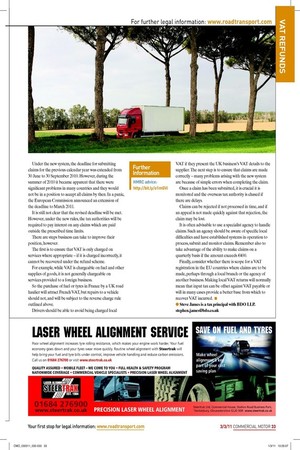The
Page 25

Page 26

If you've noticed an error in this article please click here to report it so we can fix it.
reclaim game
Reclaiming VAT spent abroad can be a complicated task. What can you do to make life easier?
An electronic VAT refund system introduced in 2010 by the EU was meant to speed up cross-border VAT reclaims for businesses throughout the EU.
However, poor implementation seems to have caused cashfiow problems for UK hauliers. With the cost of diesel being lower in Europe, reclaiming VAT on fuel has never been so important, yet so hard.
Under a separate, but linked, EU VAT change introduced on 1 January last year, most business-tobusiness cross-border services are now treated as “supplied where the customer belongs” and are subject to the reverse charge rules. This means that a supplier providing services in another EU country no longer has to register for VAT there. Instead, the customer accounts for the tax due on its VAT return in its own country.
For example, until 31 December 2009, a UK road haulier providing freight transport in France for a German business would have been required to register for VAT in France and to charge French VAT to the German customer. The German customer could then claim a refund on this VAT by making a claim to the French authorities. From 1 January 2010, the UK haulier does not charge French VAT and the French VAT registration is no longer required. Under the new rules, the German customer accounts for German VAT on its German VAT return and its claim to the French authorities is no longer needed. However, as the UK haulier now has no French VAT registration it cannot claim an offset for any French VAT it has incurred in France on its French VAT return and must instead make a refund claim to the French tax authorities.
New refund procedures
In some instances, the rules have removed the VAT charge from supplies and some businesses will no longer need to make cross-border refund claims. However, there are instances where a business that previously could claim input VAT on its foreign return now has to make a cross-border refund claim. There are also other businesses that never had any obligation for a foreign VAT registration, but which have and will continue to incur VAT in other EU countries on expenditure there.
The new refund procedures require electronic submission to the business’s own tax authority, which then passes the claim electronically to the tax authority for the country in which the VAT was incurred. The business’s own tax authority then takes no further part in the process.
What dificulties have arisen are mainly due to the varied speciications of the IT systems in the individual EU countries – remarkably, there is no common platform or format. Under the new system, the deadline for submitting claims for the previous calendar year was extended from 30 June to 30 September 2010. However, during the summer of 2010 it became apparent that there were signiicant problems in many countries and they would not be in a position to accept all claims by then. In a panic, the European Commission announced an extension of the deadline to March 2011.
It is still not clear that the revised deadline will be met. However, under the new rules, the tax authorities will be required to pay interest on any claims which are paid outside the prescribed time limits.
There are steps business can take to improve their position, however.
The irst is to ensure that VAT is only charged on services where appropriate – if it is charged incorrectly, it cannot be recovered under the refund scheme.
For example, while VAT is chargeable on fuel and other supplies of goods, it is not generally chargeable on services provided to a foreign business.
So the purchase of fuel or tyres in France by a UK road haulier will attract French VAT, but repairs to a vehicle should not, and will be subject to the reverse charge rule outlined above.
Drivers should be able to avoid being charged local VAT if they present the UK business’s VAT details to the supplier. The next step is to ensure that claims are made correctly – many problems arising with the new system are because of simple errors when completing the claim.
Once a claim has been submitted, it is crucial it is monitored and the overseas tax authority is chased if there are delays.
Claims can be rejected if not processed in time, and if an appeal is not made quickly against that rejection, the claim may be lost.
It is often advisable to use a specialist agency to handle claims. Such an agency should be aware of speciic local dificulties and have established systems in operation to process, submit and monitor claims. Remember also to take advantage of the ability to make claims on a quarterly basis if the amount exceeds €400.
Finally, consider whether there is scope for a VAT registration in the EU countries where claims are to be made, perhaps through a local branch or the agency of another business. Making local VAT returns will normally mean that input tax can be offset against VAT payable or will in many cases provide a better base from which to recover VAT incurred. ■
● Steve James is a tax principal with BDO LLP. stephen.james@bdo.co.uk



















































